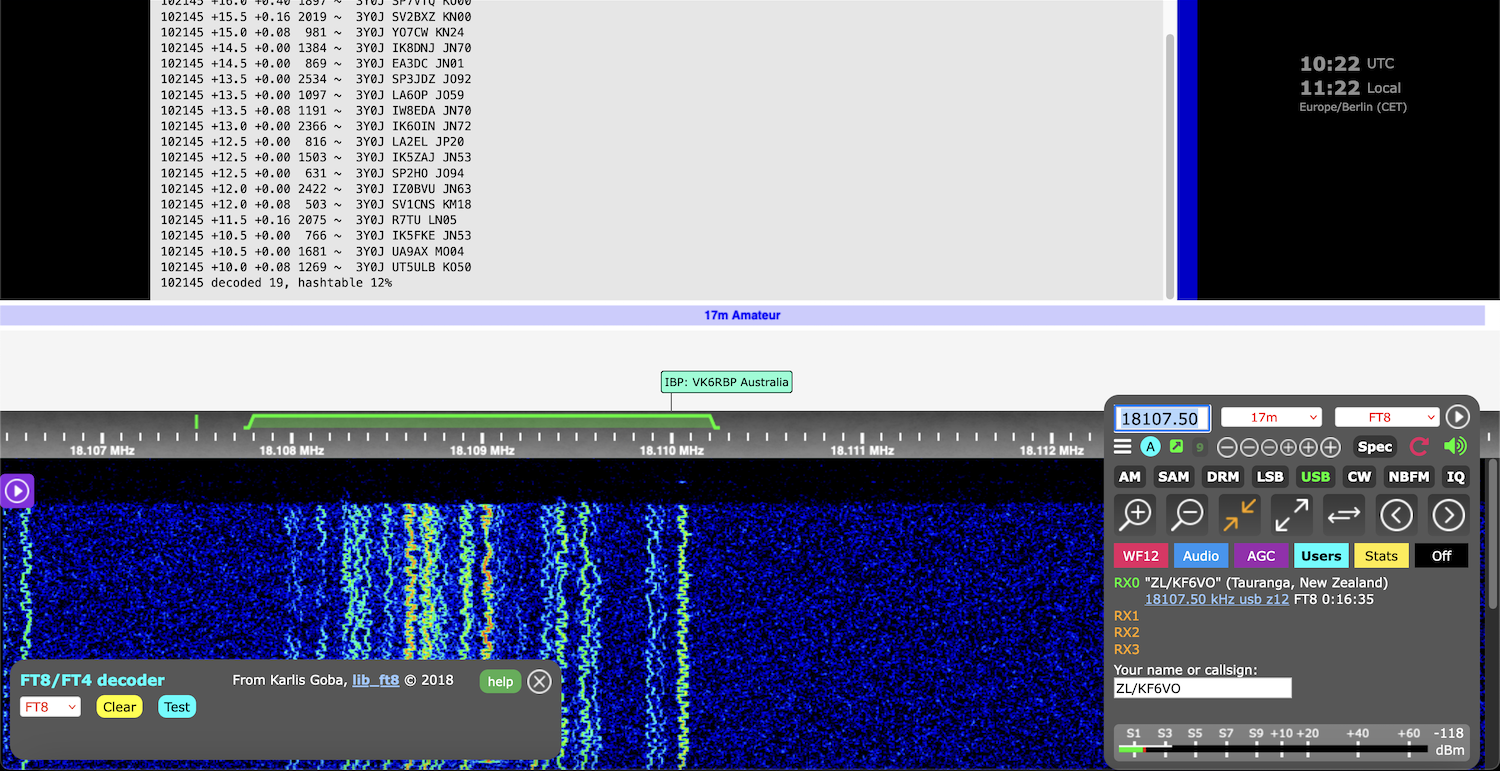The KiwiSDR 2 online store is open for orders! Please visit kiwisdr.nz
FT8?
So this turned out to be fairly easy to do thanks to a package I found called lib_ft8. But it's not clear if it will be useable on the Kiwi in the long term. Lots more work needed..


Comments
Hi John,
That would be really useful if you can get it to work, as it seem to be more useful than WSPR for some propagation monitoring, simply because there are so many people now using it.
Maybe it could send spots to PSK reporter ? I'm not sure if it already does this for WSPR in addition to WSPR net, but if not maybe that could be added too ?
One of the useful things in OpenWebRX is the ability to schedule reception of various digital modes as a background task that runs when the sdr is not being used. This can switch bands at timed intervals according to a daily schedule you can set up.
The end result is that when you look on PSK reporter it can draw a coverage circle on the map, which can give you a good idea of the best frequencies and propagation and also worst directions from your receive location.
Regards,
Martin
Other than watching the decodes scroll by, uploading to PSK reporter is about the only interesting thing to do I think. Of course FTx is a tx/rx mode. And with the tx part missing a lot of the purpose is lost.
Understood,.
How easy would it be to plot the stations spotted on a map like that used in the HFDL extension ?
Maybe different colours for different bands or S/N scores ?
That would be another way to visualise real time reception and propagation, and not just the text decodes scrolling past.
Just a passing thought...
Regards,
Martin
Wouldn't that be replicating PSKreporter?
Why not just post to it and then link to their mapping?
Hi Glenn,
Yes maybe, but I thought John was looking for inspiration to make the extension more visually 'interesting' :-)
PSK Reporter is currently suffering quite badly from information overload, and it has a user limit of only so many searches per day.
I also find there is a limited amount of information you can extract from it, as it only seems to show the last reported spots of a particular call. You can download a list, but this also only seems to have one entry per call / reporter combination. At least with WSPRNET you can get a full history.
I could see a real time map display of just the stations a particular KiWi is hearing, could be quite useful for propagation monitoring, without having to use PSK Reporter and the requirement to set up specific search criteria, and assuming that you haven't already used up you daily quota. The KiWi has capability for mapping, so some of the basic elements may already exist.
But as I said previously, it was just a passing thought...
Regards,
Martin
In writing code to upload spots to PSKReporter I've come to understand it is very different from WSPRnet. The latter wants every single spot reported, every 2 minutes (WSPR-2), no matter what (obviously some dup filtering etc applied before uploading).
PSKReporter wants more of a "summary" of what is being heard, reported every 5 minutes (or when the UDP packet fills up). Unique callsigns should be reported no more frequently than once per 5 minutes or, more ideally, once per hour. Unless there is a "change" the precise definition of which is left to the upload developer. It's suggested a change might a band change. So e.g. automatic QSY within an FT8 window doesn't cause a spot upload. But switching from FT8 to FT4 on the same band would. Or grid change (e.g. /MM)
Hi John,
That sounds about right.
I've been trying to make some A/B antenna tests using PSK reporter, and in comaparison to WSRNET it's almost impossible. Which is a pity as several runs of WSPR take ages, whereas FT8 should theoretically be much faster, but in practice it isn't because of the slow report updates and overwriting of previous spots. I also wish that FT8 sent a full locator and transmitter power like WSPR, but you can't have everything (it would seem).
I've also got an experimental licence for the 40MHz band, and trying to observe propagation changes in real time using PSK reporter is difficult, especially as many signal enhancements are short lived.
Fortunately I can see what's going on by directly using the OpenWebRX sdr FT8 decoder in the GUI, which is also uploading spots to WSPRNET and PSK reporter, as well as plotting locator squares on it's own internal map.
OpenWebRX SDR
http://wessex.hopto.org:8060/#freq=145500000,mod=nfm,sql=-150
Map page
http://wessex.hopto.org:8060/map
Regards,
Martin
@jks
Hi John,
If you haven't already you could perhaps have a look how the spot uploads for FT8 are handled in Digiskimmer located at https://github.com/lazywalker/DigiSkimmer/tree/master/digiskr .
Best regards,
Ben